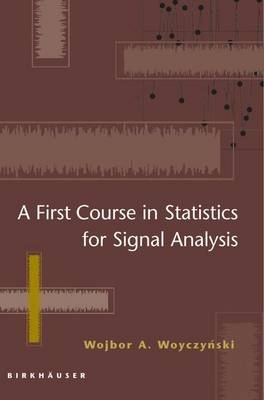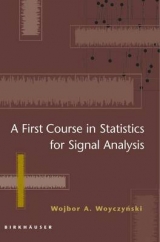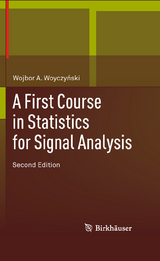A First Course in Statistics for Signal Analysis
Seiten
2006
Birkhauser Boston Inc (Verlag)
978-0-8176-4398-0 (ISBN)
Birkhauser Boston Inc (Verlag)
978-0-8176-4398-0 (ISBN)
- Titel erscheint in neuer Auflage
- Artikel merken
Zu diesem Artikel existiert eine Nachauflage
Suitable for one-semester course in statistical signal analysis for a broad audience of students in engineering and the physical sciences, this title places emphasis on fundamental concepts and relationships in the statistical theory of stationary random signals, explained in a concise, yet fairly rigorous presentation.
This essentially self-contained, deliberately compact, and user-friendly textbook is designed for a first, one-semester course in statistical signal analysis for a broad audience of students in engineering and the physical sciences. The emphasis throughout is on fundamental concepts and relationships in the statistical theory of stationary random signals, explained in a concise, yet fairly rigorous presentation. Fourier series and transforms - fundamentally important in random signal analysis and processing - are developed from scratch, emphasizing the time-domain vs. frequency-domain duality. Basic concepts of probability theory, laws of large numbers, the stability of fluctuations law (central limit theorem), and statistical parametric inference procedures are presented so that no prior knowledge of probability and statistics is required; the only prerequisite is a basic two - three semester calculus sequence.
This title features: introduction of the fundamental concept of a stationary random signal and its autocorrelation structure; power spectra of stationary signals and transmission analysis; filter design with optimal signal-to-noise ratio; computer simulation algorithms of stationary random signals with a given power spectrum density; complementary bibliography for readers who wish to pursue the study of random signals in greater depth; and, many diverse examples as well as end-of-chapter problems and exercises. Developed by the author over the course of several years of classroom use, "A First Course in Statistics for Signal Analysis" may be used by junior/senior undergraduates or graduate students in electrical, systems, computer, and biomedical engineering, as well as the physical sciences. The work is also an excellent resource of educational and training material for scientists and engineers working in research laboratories.
This essentially self-contained, deliberately compact, and user-friendly textbook is designed for a first, one-semester course in statistical signal analysis for a broad audience of students in engineering and the physical sciences. The emphasis throughout is on fundamental concepts and relationships in the statistical theory of stationary random signals, explained in a concise, yet fairly rigorous presentation. Fourier series and transforms - fundamentally important in random signal analysis and processing - are developed from scratch, emphasizing the time-domain vs. frequency-domain duality. Basic concepts of probability theory, laws of large numbers, the stability of fluctuations law (central limit theorem), and statistical parametric inference procedures are presented so that no prior knowledge of probability and statistics is required; the only prerequisite is a basic two - three semester calculus sequence.
This title features: introduction of the fundamental concept of a stationary random signal and its autocorrelation structure; power spectra of stationary signals and transmission analysis; filter design with optimal signal-to-noise ratio; computer simulation algorithms of stationary random signals with a given power spectrum density; complementary bibliography for readers who wish to pursue the study of random signals in greater depth; and, many diverse examples as well as end-of-chapter problems and exercises. Developed by the author over the course of several years of classroom use, "A First Course in Statistics for Signal Analysis" may be used by junior/senior undergraduates or graduate students in electrical, systems, computer, and biomedical engineering, as well as the physical sciences. The work is also an excellent resource of educational and training material for scientists and engineers working in research laboratories.
Introduction Notation Description of Signals Spectral Representation of Deterministic Signals: Fourier Series and Transforms Random Quantities and Random Vectors Stationary Signals Power Spectra of Stationary Signals Transmission of Stationary Signals through Linear Systems Optimization of Signal-to-Noise Ratio in Linear Systems Gaussian Signals, Correlation Matrices, and Sample Path Properties Discrete Signals and Their Computer Simulations Bibliographical Comments
| Erscheint lt. Verlag | 8.9.2006 |
|---|---|
| Zusatzinfo | 1 |
| Verlagsort | Secaucus |
| Sprache | englisch |
| Maße | 234 x 156 mm |
| Gewicht | 710 g |
| Einbandart | Paperback |
| Themenwelt | Mathematik / Informatik ► Informatik ► Theorie / Studium |
| Mathematik / Informatik ► Mathematik ► Analysis | |
| Mathematik / Informatik ► Mathematik ► Angewandte Mathematik | |
| Mathematik / Informatik ► Mathematik ► Statistik | |
| Naturwissenschaften | |
| ISBN-10 | 0-8176-4398-2 / 0817643982 |
| ISBN-13 | 978-0-8176-4398-0 / 9780817643980 |
| Zustand | Neuware |
| Haben Sie eine Frage zum Produkt? |
Mehr entdecken
aus dem Bereich
aus dem Bereich
Grundlagen – Anwendungen – Perspektiven
Buch | Softcover (2022)
Springer Vieweg (Verlag)
CHF 48,95
Eine Einführung in die Systemtheorie
Buch | Softcover (2022)
UTB (Verlag)
CHF 34,95
was jeder über Informatik wissen sollte
Buch | Softcover (2024)
Springer Vieweg (Verlag)
CHF 53,15





